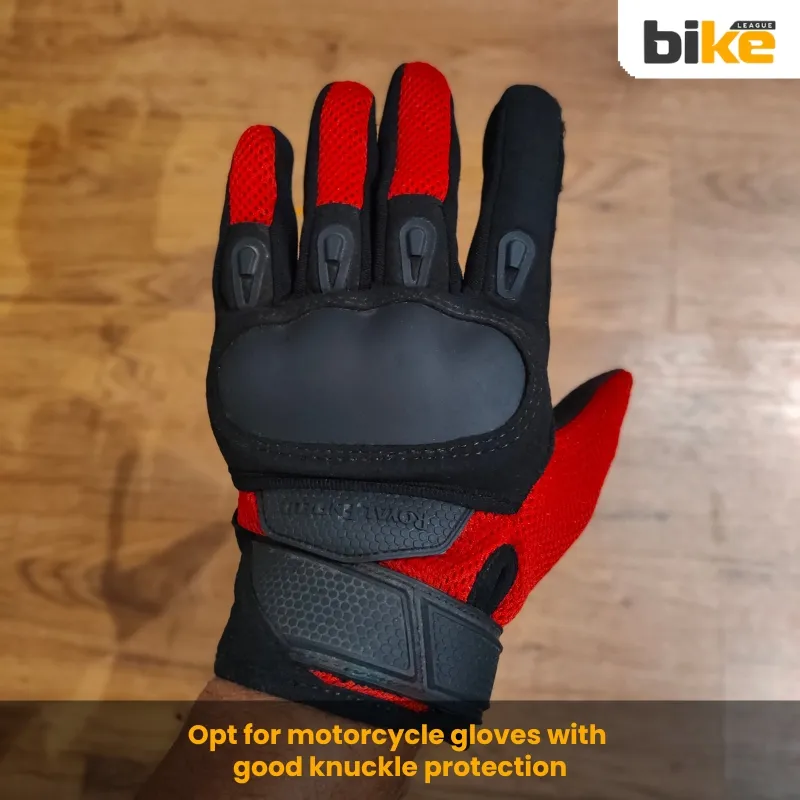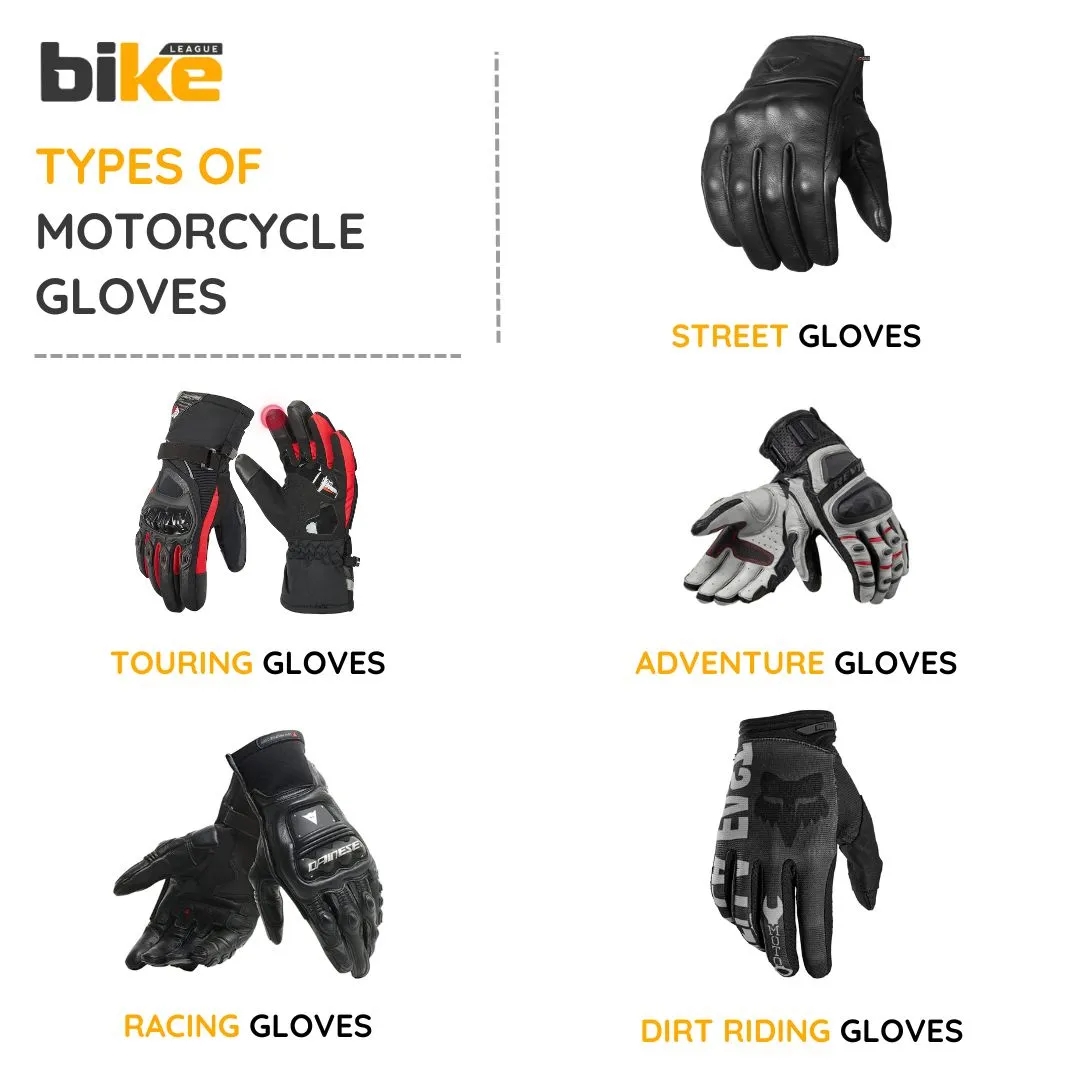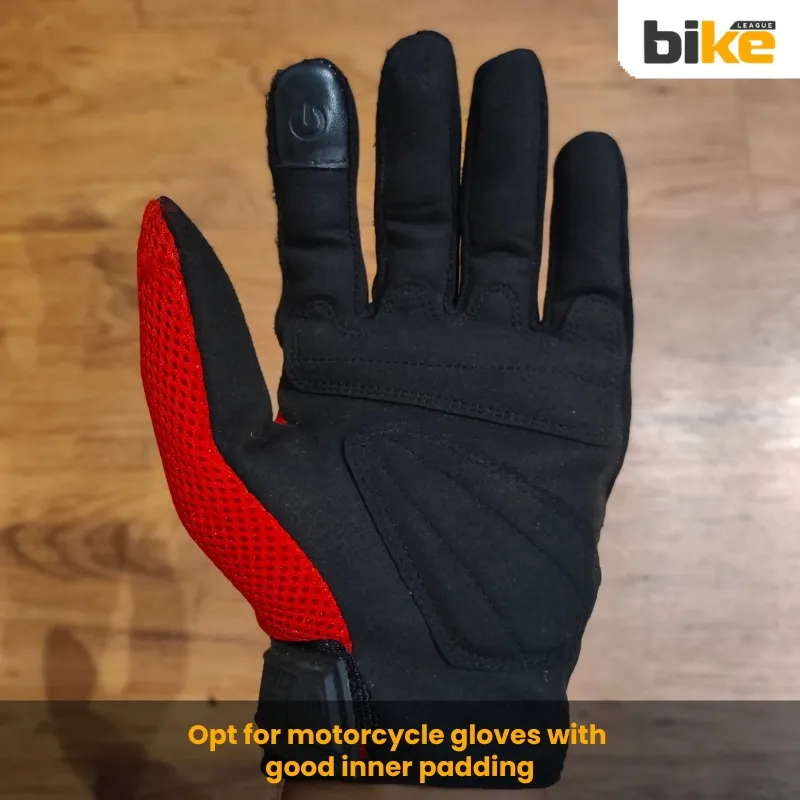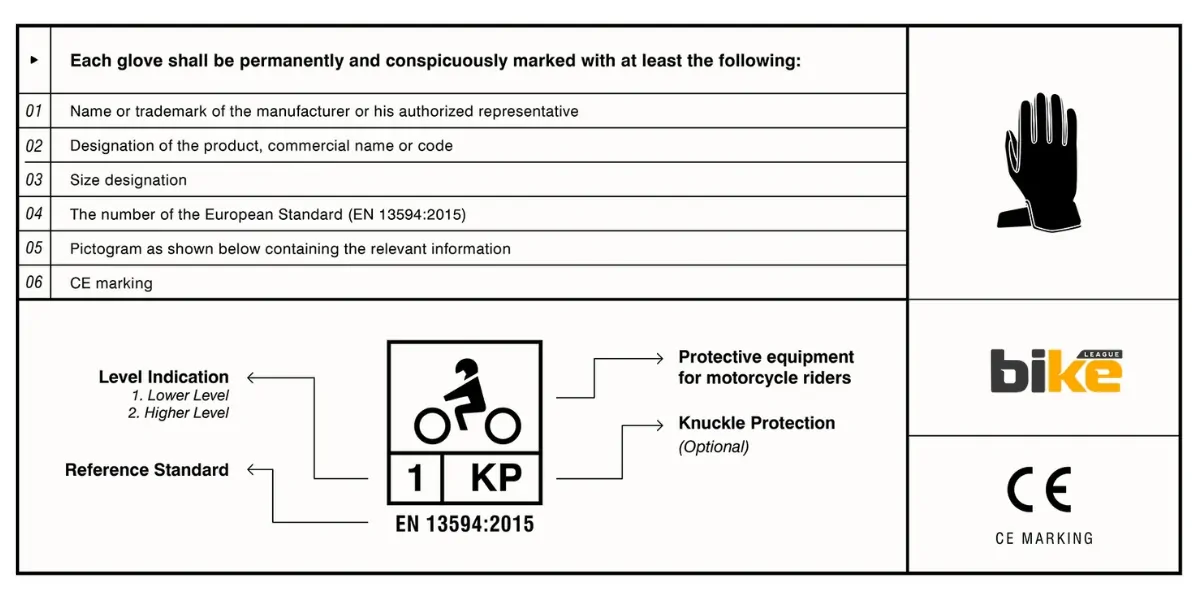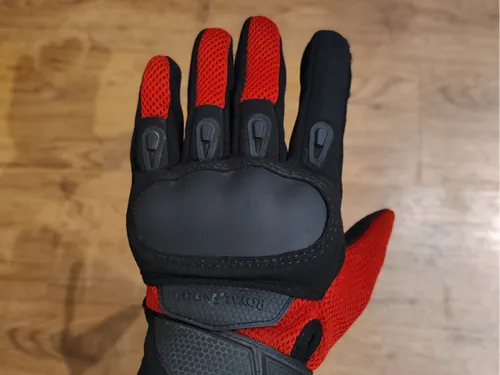
Long story short – Biker gloves are a vital part of riding motorcycle accessories and are mandatory in all riding scenarios except commuting. Here we discuss different motorcycle gloves, like leather gloves, hybrid gloves, textile gloves, etc.
Motorcycle gloves are a vital cog in the motorcycle accessories list of a professional rider. Like helmets, jackets, shoes, etc., gloves are also integral to the safety aspect of a rider. In long rides in varying weather conditions, gloves are a boon for the hands of the rider.
In reality, riders consider gloves less important than helmets and jackets. However, gloves also provide essential protection in the event of a crash. In this article, we will discuss all the aspects of motorcycle gloves and what to consider when buying riding gloves.
What are riding gloves or motorcycle gloves?
As the name suggests, motorcycle gloves are worn while riding a motorcycle. Riding gloves come in various shapes and sizes and are made of different materials.
Are motorcycle gloves necessary?
Yes, if you go for long rides, motorcycle gloves are mandatory. In harsh environmental conditions, like hot and cold climates, hands can feel the same, affecting ride quality and feel. Gloves are also compulsory for off-roaders, while they are optional for street riders and commuters. Another benefit is the protection they provide in case of a crash. They protect your skin from scratches, abrasions, cuts, and bruises.
Type of motorcycle gloves
The main types of motorcycle gloves in the Indian market are as follows.
1. Street or Commuter gloves
These gloves are designed for use in city riding conditions and are mainly made of leather or textile material. Leather motorcycle gloves offer more protection than other types of gloves in summer. Still, they are not suitable for wet conditions. Always opt for all-weather commuter gloves, which can become handy in all environments.
Pros of street gloves
- Ease of Use: Easy to wear and remove, suitable for daily commuting
- Breathability: Often made with breathable materials for comfort
Cons of street gloves
- Advanced Protection: May lack advanced protective features found in racing or touring gloves
- Insulation: Limited insulation for cold weather
2. Adventure gloves
Adventure gloves offer the same level of comfort and protection as other types of gloves. They must be lightweight to facilitate quick hand reflexes while providing good protection. The primary materials used in adventure gloves are leather and textiles.
Pros of adventure gloves
- Made of mesh, leather, and rubber, offering flexibility and protection
- Often waterproof and provide good grip, suitable for diverse weather conditions
Cons of adventure gloves
- Can be more expensive than street gloves
- May not offer the same level of protection as racing gloves
3. Touring gloves
It is one of the most expensive types of motorcycle gloves, with various sophisticated materials to provide advanced protection and rigid construction. Touring gloves need to face all types of extreme weather conditions for prolonged periods. They need to be waterproof, not too heavy, and not compromise the rider’s comfort.
Pros of touring gloves
- Extra Padding: Extra padding to reduce hand fatigue, especially on long rides
- Durability: Robust materials and construction for durability, often including waterproofing and insulation
Cons of touring gloves
- Cost: Can be more expensive due to advanced features
- Weight and Ventilation: May be heavier and less ventilated than summer gloves
4. Racing gloves
These gloves offer the most protection and are made of pure, thick leather with limited ventilation to provide extra safety. Also, armoured materials are present to avoid severe damage to the hands.
Pros of racing gloves
- High Protection: High protection with armour and reinforced materials, designed for high-speed impacts and abrasion resistance.
- Optimal Grip: Features like pre-curved fingers and hard knuckle protection for optimal grip and control
Cons of racing gloves
- Expense: Expensive compared to other types
- Comfort: Can be less comfortable for everyday use due to limited ventilation
5. Dirt / Off-road riding gloves
Dirt gloves offer the least protection and minimal armouring. They must be lightweight, flexible, and provide excellent ventilation for dirt rides. Dirt gloves are not durable and are cheaper than other glove types.
Pros of dirt riding gloves
- Flexibility: Flexible and lightweight, allowing for better control
- Reinforcement: Reinforced in key areas for protection against rough terrain
Cons of dirt riding gloves
- Protection Level: May not offer as much protection as racing gloves
- Suitability for Long Rides: Not ideal for long-distance touring
Types of motorcycle gloves according to material
1. Leather motorcycle Gloves
Leather motorcycle gloves are a popular choice among motorcyclists due to their durability and protective qualities. They are typically made from cowhide, goatskin, or kangaroo leather.
Pros of Leather motorcycle Gloves
- High Abrasion Resistance: Leather offers excellent protection against abrasions, making it ideal for high-speed riding and racing
- Durability: Leather motorcycle gloves are long-lasting and can withstand significant wear and tear
- Comfort: Over time, leather motorcycle gloves mold to the shape of the rider’s hands, providing a custom fit
Cons of Leather Gloves
- Cost: High-quality leather gloves can be expensive
- Break-in Period: Leather gloves require a break-in period to become comfortable
- Weather Sensitivity: Leather is less effective in wet conditions unless treated for waterproofing
2. Textile motorcycle Gloves
Textile motorcycle gloves are made from synthetic materials such as nylon, polyester, and Kevlar. They are designed to offer specific qualities like waterproofing and breathability.
Pros of Textile motorcycle Gloves
- Weather Resistance: Textile motorcycle gloves often feature waterproof membranes like GORE-TEX® or hydratex®, making them suitable for wet conditions
- Breathability: These gloves are generally more breathable than leather, making them comfortable for long rides in varying climates
- Cost-Effective: Textile motorcycle gloves are usually less expensive than leather gloves
Cons of Textile motorcycle Gloves
- Less Durable: Textile motorcycle gloves may not last as long as leather gloves and can be less resistant to abrasions
- Fit and Comfort: They may not provide the same snug fit as leather gloves and can feel less comfortable initially
3. Mesh Gloves
Mesh gloves are designed for maximum airflow and are typically used in hot weather conditions. They are often made from a combination of mesh and other materials like leather or synthetic fabrics.
Pros of Mesh Gloves
- Ventilation: Mesh gloves provide excellent airflow, keeping hands cool and dry in hot weather
- Lightweight: These gloves are generally lighter and more comfortable for summer riding
Cons of Mesh Gloves
- Limited Protection: Mesh gloves offer less protection compared to full leather or textile gloves, especially in high-impact areas
- Durability: They may wear out faster due to the lightweight materials used
4. Hybrid motorcycle Gloves
Hybrid motorcycle gloves combine materials like leather, mesh, and textiles to offer a balance of protection, comfort, and functionality. These gloves are versatile and can be used in various riding conditions.
Pros of Hybrid motorcycle Gloves
- Versatility: Hybrid motorcycle gloves can be used in different weather conditions and riding styles, offering a good balance of features
- Enhanced Protection: hybrid motorcycle gloves often include reinforced areas with materials like Kevlar or hard knuckle protectors for added safety
Cons of Hybrid motorcycle Gloves
- Complex Design: The combination of materials can make these gloves more complex and potentially more expensive
- Fit Issues: Finding the right fit can be challenging due to the varied materials and construction
What specific features should we look for in motorcycle gloves in India to ensure maximum protection?
When choosing motorcycle gloves in India for maximum protection, prioritise the following features:
| Feature | Why It Matters | Details to Look For |
|---|---|---|
| CE Certification (EN 13594:2015) | Verified safety performance | Level 1 (good), Level 2 (best), “KP” for knuckles |
| Knuckle & Palm Protection | Shields from impact/abrasion | Hard armor knuckles, palm sliders, reinforcement |
| Abrasion-Resistant Materials | Prevents road rash | Goatskin/kangaroo leather, double stitching |
| Ventilation & Climate Adaptation | Comfort in Indian weather | Mesh, perforated leather, moisture-wicking liners |
| Gauntlet/Wrist Guard | Wrist/forearm safety | Long cuff/gauntlet styles, adjustable straps |
| Fit & Ergonomics | Prevents glove slip/fatigue | Pre-curved fingers, elastic/stretch panels, secure fit |
1. Certified Impact Protection
- CE Certification: Choose gloves that are CE certified according to EN 13594:2015. Level 2 offers superior impact and abrasion protection, and gloves with “KP” have proven knuckle protection.
- Reinforced Knuckles: Look for hard armour (carbon fibre, TPU, or D3O) to protect during falls.
- Palm Sliders: Essential for protecting the scaphoid (palm bone) during slides; should be made of abrasion-resistant materials.
2. Premium Materials
- Abrasion-Resistant Leather: Goatskin or kangaroo leather for palms and key impact areas. Synthetic leather and mesh blends are common for breathability and still offer protection.
- Double or Triple Stitching: Reinforces critical seams so gloves don’t unravel on impact.
3. Climate-Appropriate Design
- Ventilation: Mesh panels or perforated leather on the back of the hand and fingers for airflow, crucial for Indian summers.
- Moisture-Wicking or Quick-Dry Liners: Prevents sweat build-up and keeps grip secure.
- Weatherproof Membrane: If you ride year-round or in the monsoon, look for waterproof (e.g., Gore-Tex, Drystar XF) or windproof features.
4. Full Gauntlet or Longer Cuffs
- Full Gauntlet Styles: Extended cuffs offer superior wrist and lower forearm protection; often required for Level 2 certification and for touring or sports riding.
5. Ergonomic and Comfort Features
- Pre-Curved Fingers: Less fatigue, more natural grip.
- Adjustable Closure/Wrist Strap: Secure fit to prevent the glove from sliding off during a crash.
- Stretch Panels/Elastic: For dexterity and flexibility, especially on the throttle hand.
6. Additional Safety & Modern Touches
- Pinky-Ring Finger Bridge: Sometimes stitched together to reduce finger roll injury in a slide.
- Scaphoid Protection: Added protection for a commonly fractured bone in falls.
- Touchscreen Compatibility: For convenience, so you don’t have to remove gloves to use your phone/GPS.
7. Fit & Quality Control
- Ensure the gloves fit snugly without restricting movement. Loose gloves may come off in an accident, compromising protection.
- Check for proper CE labelling inside the glove; beware of counterfeits.
What is CE Certification (EN 13594:2015) for motorcycle gloves?
CE Certification (EN 13594:2015) for motorcycle gloves is a European safety standard that ensures gloves offer adequate protection specifically for motorcycle riders. This standard involves rigorous testing for impact resistance, abrasion resistance, tear strength, seam integrity, and retention (the ability of the glove to stay on your hand during a crash).
- EN 13594:2015 applies to all motorcycle gloves intended to reduce hand and wrist injuries in accidents. This designation number shows the recognised standard the glove has been tested to
- Figure 1 or 2 shows its CE rating (‘1’ for a basic pass, ‘2’ for a more advanced pass). Gloves are rated at two performance levels. Level gives basic protective performance but with greater dexterity and comfort. Level 2 provides higher protection (especially against impact and abrasion) but can be heavier or less flexible.
- A code such as “KP” indicates that the glove has passed a dedicated knuckle impact protection test, which is mandatory for Level 2 and optional for Level 1.
- Gloves must display a CE mark and label with the EN 13594:2015 standard and the performance level.
What tests are done for CE certification for motorcycle gloves?
Within the CE standard, there are six mandatory elements that a glove must go through to achieve a rating, and one optional test for gloves if they’re to meet the higher standard.
Test 1: Cuff Length
Measure from the wrist line to the cuff’s end. Level 1 requires at least 15mm; Level 2 requires a minimum of 50mm.
Test 2: Restraint
This test checks if the glove stays on during an accident. A dummy wrist holds the glove while clamps attempt to pull it off. Level 1 requires a force of 27 Newtons (N) and Level 2 requires 52N. The glove must remain in place for 30 seconds.
Test 3: Tear Strength
Tear resistance is tested at three areas: the palm, cuff, and fourchettes. For Level 1, the palm must withstand 25 N, the cuff 18 N, and the fourchettes 18 N. For Level 2, these values increase to 35 N, 30 N, and 25 N, respectively.
Test 4: Seam Strength
Seam strength is tested similarly to tear strength. The main seams need to survive 6 N/mm for Level 1 and 10 N/mm for Level 2; fourchettes require 4 N/mm for Level 1 and 7 N/mm for Level 2.
Test 5: Impact Abrasion Resistance
A sample is dropped onto abrasive material to test its durability. Level 1 requires a minimum of three seconds before puncture, with an average of four seconds across four samples. Level 2 requires six seconds for a single sample and an average of eight seconds.
Test 6 (Optional for Level 1): Impact Protection of Knuckles
For Level 2 certification, this test measures the impact resistance. A 2.5kg striker hits the glove with 5 joules of force. Level 1 allows a maximum of 9 kilonewtons (kN) for a single strike and 7 kN for the average; Level 2 requires a maximum of 4 kN for both measures. Any damage during testing results in an automatic fail.
FAQ related to buying motorcycle gloves in India
1. Where to buy motorcycle gloves?
Always purchase motorcycle accessories offline, as you want to know the product’s fit, size, and feel. On online websites, rates may be lower than offline, but there is no way to verify product quality, and there’s a risk of damage and fraud. You can also bargain to get products at an online price.
2. What kind of motorcycle gloves do I need?
It all depends on the conditions and the ride situation. As discussed above, there are different motorcycle gloves for various scenarios.
3. How should motorcycle gloves fit?
Gloves should be neither too loose nor too tight, and should not be too close, as this can restrict blood flow and cause discomfort. Fingers should move comfortably after wearing the gloves. There should be no excess material that could bunch up and interfere with your grip on the handlebars. If possible, have a short ride with gloves to get a feel for the product.
4. Which motorcycle glove type is best for cold weather?
For cold weather conditions, leather material gloves are the best in the business. Also, check out gloves with minimal air ventilation.
5. What are the best motorcycle gloves for wet weather?
For wet weather conditions, textile material gloves are the best. Also, consider gloves with waterproof membranes for riding in wet conditions.
6. Which additional features should we look for in bike gloves?
- Touchscreen compatibility: allows you to use your smartphone without taking your gloves off.
- Reflective material: improves visibility in low-light conditions.
- Ventilation: helps keep your hands cool in hot weather.
- Wrist closure: ensures a secure fit and prevents the gloves from slipping off.
7. What are heated biker gloves?
Heated motorcycle gloves keep your hands warm for several hours after charging. To keep gloves warm for a long day or trip, securely wire them to the motorcycle battery. These gloves are only suitable for harsh, cold conditions. Otherwise, it is not that worthy.
8. What are the best biker gloves for hot weather?
For hot weather conditions, textile material gloves are the best. Also, look for gloves with sufficient air ventilation.
9. When to replace biker gloves?
If any of the glove’s surfaces are worn and torn, it is high time to replace them with a brand-new pair.
10.What are the safest biker gloves?
Racing gloves are the safest as they provide the most features and protection, such as full-gauntlet construction and reinforced knuckle guards.
11. Which are the international biker glove brands?
Some of the renowned international brands are
12. Which are the domestic motorcycle glove brands?
When it comes to domestic brands, recommended ones are
14. What are the best gloves available on the market?
This article provides tips for purchasing motorcycle gloves. That is the sole purpose of this article; hence, we will not suggest individual products here.
Other related articles from Bikeleague India
- What all basic motorcycle accessories should a rider have
- Must have bike accessories for a long distance trip
- Motorcycle helmet in India – All in one buying guide
- Second hand motorcycle:Things to know when buying It
- Different types of motorcycles explained
Conclusion
In this article, we have discussed almost all buying guide topics related to motorcycle gloves, types and things to note while buying. If you have any other questions or queries, email us at bikeleague2017@gmail.com. You can also share your doubts or opinions in the comments section below. We are always eager to help and assist you. Also, here are several social media platforms of Bikeleague India to raise your suspicions.

